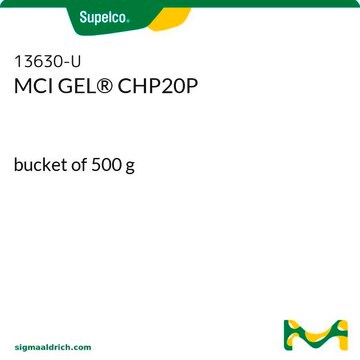13623-U
Sepabeads® SP-207 Polymeric Adsorbent
20-60 mesh, bucket of 1000 g
Zaloguj sięWyświetlanie cen organizacyjnych i kontraktowych
About This Item
Polecane produkty
Nazwa produktu
Sepabeads® SP-207, bucket of 1000 g
Formularz
solid
opakowanie
bucket of 1000 g
metody
LPLC: suitable
powierzchnia
650 m2/g
Matryca
brominated styrene-divinylbenzene
grupa aktywna macierzy
polymer
wielkość cząstki
20-60 mesh
wielkość porów
~1.20 mL/g pore volume
105 Å mean pore size
gęstość
1.18 g/mL at 25 °C (true wet)(lit.)
metoda separacji
reversed phase
Powiązane kategorie
Opis ogólny
Sepabeads® SP-207 is a nonionic polystyrene-divinylbenzene polymer resin used as column packing material. It is widely used as a adsorbent for purification in biopharmaceutical applications.
Zastosowanie
- Sepabeads® SP-207 was used in kinetic and thermodynamics investigation for adsorption/desorption behavio of anthocyanin pigments.
- Sepabeads® SP-207 was used as column packing material for purification of phenolic fraction.
Dense resin popular for collecting hydrophobic compounds from thick fermentation broths. The bromination makes it superior to styrene-divinylbenzene polymers: strongly hydrophobic, high density, large capacity. Especially useful with upflow fluidized bed applications.
Inne uwagi
Swelling in toluene = 18%
Informacje prawne
Diaion is a registered trademark of Mitsubishi Chemical Corp.
Sepabeads is a registered trademark of Mitsubishi Chemical Corp.
Ta strona może zawierać tekst przetłumaczony maszynowo.
Kod klasy składowania
11 - Combustible Solids
Klasa zagrożenia wodnego (WGK)
WGK 3
Temperatura zapłonu (°F)
Not applicable
Temperatura zapłonu (°C)
Not applicable
Środki ochrony indywidualnej
Eyeshields, Gloves, type N95 (US)
Wybierz jedną z najnowszych wersji:
Masz już ten produkt?
Dokumenty związane z niedawno zakupionymi produktami zostały zamieszczone w Bibliotece dokumentów.
Klienci oglądali również te produkty
An optimal extraction solvent and purification adsorbent to produce anthocyanins from black rice (Oryza sativa cv. Heugjinjubyeo).
Kang, You Jin, Seung Won Jung, and Seung Ju Lee.
Food Technology and Biotechnology, 23, 97-106 (2014)
Irena Palíková et al.
Journal of agricultural and food chemistry, 57(15), 6584-6589 (2009-07-04)
The effect of Lonicera caerulea L. (blue honeysuckle) phenolic fraction (18.5% anthocyanins) on cell viability and against oxidative damage in low density lipoproteins (oxLDL), in rat microsomes and in primary cultures of rat hepatocytes and human umbilical vein endothelial cells
Renáta Myjavcová et al.
Journal of chromatography. A, 1217(51), 7932-7941 (2010-11-30)
Anthocyanins from the fruit Lonicera caerulea L. var. kamtschatica (blueberry honeysuckle, Caprifoliaceae) were studied via (semi)preparative chromatographic fractionation followed by MS and μLC/MS analysis. The extraction procedure was optimized with respect to analytical purposes as well as its potential use
Nasz zespół naukowców ma doświadczenie we wszystkich obszarach badań, w tym w naukach przyrodniczych, materiałoznawstwie, syntezie chemicznej, chromatografii, analityce i wielu innych dziedzinach.
Skontaktuj się z zespołem ds. pomocy technicznej







